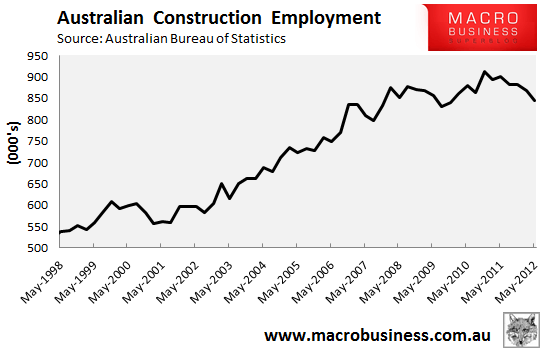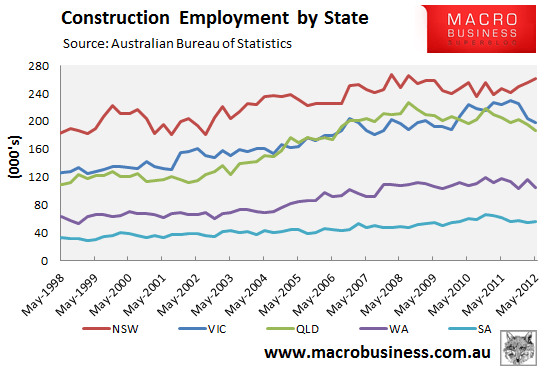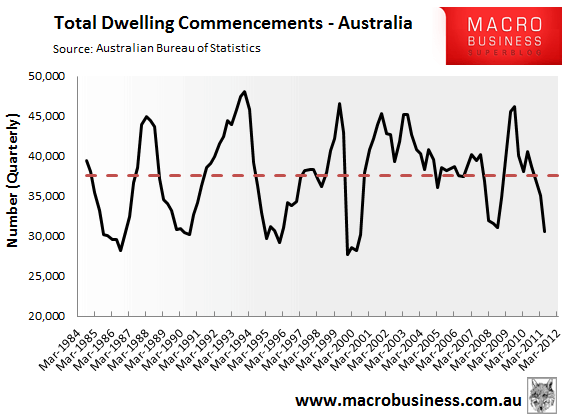
Fairfax’s Adele Ferguson today published an important article on the growing number of collapses in the building industry, where at least two companies a day are going under, mostly in New South Wales and Victoria:
The latest statistics on liquidations and voluntary administrations show that since January 1 more than 363 companies in the building industry, excluding mining, have collapsed, more than 200 of them from New South Wales and 95 from Victoria.
What is even more alarming is the trend seems to be getting worse, with 30 building companies failing in March, 33 in April, 51 in May, 63 in June and a whopping 40 collapsing in the first 10 days of July.
Profit margins have shrunk to between zero and 2 per cent.
It isn’t a pretty picture and supports the general economic statistics, which show that as a proportion of nominal gross domestic product (GDP) building activity in Australia is close to a 35-year low. Outside mining, Australia is in the midst of a downturn in residential, commercial and public sector infrastructure activity.
A survey by Evans & Partners in May and June of private companies, consultants, service providers and customers in the construction sector to identify emerging issues, revealed a bleak outlook for the sector, ex-mining.
”If exposure to the resources sector is limited or non-existent, the industry is observing the passing of a high-rise residential peak in Melbourne, commercial office ‘back fill’ and/or shuffling the deck chairs taking precedence over new office build, all levels of government minimising (or zero-ing) their infrastructure spending … Even for those who can secure work, the margins have become wafer thin and [they] often bet on improved buying terms to make a profit. The forward pipeline is thin and the outlook bleak,” the survey report notes.
The outlook for Victoria is poor. The report cited an example of one project attracting 27 builders in the tender process versus three to four previously, which is hurting profit margins. It said unsolicited emails from suppliers, subcontractors and individuals looking for work had increased enormously. ”A reasonable amount of work is available for tender, but is being purely price driven – pre-existing relationships account for nothing now”…
The overwhelming theme of the survey is that the country’s building sector ex-mining is being hit so hard from so many different angles that if it wasn’t for the mining boom the severity of the downturn in the sector would have had a big impact on the broader economy.
Certainly, official labour force data from the Australian Bureau of Statistics (ABS) supports the contention that the construction sector is struggling. According to the ABS, the sector has lost 66,200 jobs nationally since November 2010, representing 7% of the construction workforce (see below chart). The sector is employer to just over 7% of the Australian workforce, according to the ABS.

Construction sector job losses have been experienced across the mainland, with the exception of New South Wales, with the greatest losses occuring in Victoria (-31,700 jobs or -14% of workforce) and Queensland (-30,500 jobs or -14% of workforce):

In addition to the unwinding of various government stimulus programs (e.g. the ‘School Halls’ project), a key reason behind the contraction in the construction industry relates to the slump in dwelling construction, which has hit decade lows (see below chart).
With Chinese authorities seeking to shift growth away from commodity-intensive fixed asset investment towards less commodity-intensive services and consumption, as well as Deloitte Access Economics today forecasting that Australia’s mining investment boom has only two-years to run, authorities will hopefully begin to ask the question where will tomorrow’s growth come from?
Twitter: Leith van Onselen. Leith is the Chief Economist of Macro Investor, Australia’s independent investment newsletter covering trades, stocks, property and yield. Click for a free 21 day trial.


